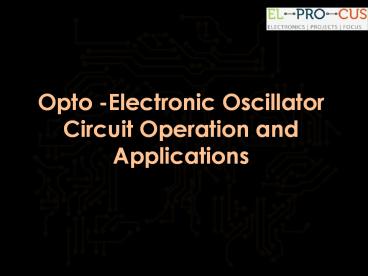Opto-Electronic Oscillator Circuit Working and Applications - PowerPoint PPT Presentation
Title:
Opto-Electronic Oscillator Circuit Working and Applications
Description:
This article tells about what is an Opto electronic oscillator, working of the oscillator, multi-loop Opto-electronic oscillator, and its applications. – PowerPoint PPT presentation
Number of Views:277
Title: Opto-Electronic Oscillator Circuit Working and Applications
1
Opto -Electronic Oscillator Circuit Operation and
Applications
2
Opto-Electronic Oscillator Circuit Operation and
Applications
Introduction
- The Opto-electronic oscillator circuit is
comparable to the optoelectronic feedback
circuits which are established by the Neyer and
Voges in the 1982 year. In 1984 by Nakazawa and
later on in the year 1992 by Lewis. The
Opto-electronic oscillator is based on the
converting continuous light energy from the pump
laser to radio frequency, microwave or mm-wave
signal.
http//www.elprocus.com/
3
Opto-Electronic Oscillator Circuit Operation and
Applications
What is an Opto-Electronic Oscillator?
- The Optoelectronic oscillator is an
Opto-electronic circuit. - The output of the circuit is in the form of the
sine wave or modulated continuous wave signal. - It is a device where the phase noise of the
oscillator does not increase the frequency. - It is subject to the implementation of
the electronic oscillators like crystal
oscillator, dielectric resonator, and sir
dielectric resonator.
http//www.elprocus.com/
4
Opto-Electronic Oscillator Circuit Operation and
Applications
Opto-Electronic Oscillator
http//www.elprocus.com/
5
Opto-Electronic Oscillator Circuit Operation and
Applications
Basic Operation of the OEO
- The following figure shows the operation of the
Opto-electronic oscillator.
http//www.elprocus.com/
6
Opto-Electronic Oscillator Circuit Operation and
Applications
Basic Operation of the OEO
- By observing the circuit, the Optoelectronic
oscillator starts with continuous wave laser is
penetrating into the intensity modulator. - The output of optical intensity modulator is
passed through a long optical fiber delay line
and into a photodiode. - The improved electrical signal is applied and
approved through an electronic bandpass filter.
http//www.elprocus.com/
7
Opto-Electronic Oscillator Circuit Operation and
Applications
Basic Operation of the OEO
- To complete the Opto electronic cavity the output
of the filter is connected to the RF input of
intensity modulator. - If the gain of the cavity is greater than the
loss, then the optoelectronic oscillator is will
start the oscillation. - The electronic band pass filter selects the
frequency of the diminished the other free
running modes of the cavity which is below the
threshold.
http//www.elprocus.com/
8
Opto-Electronic Oscillator Circuit Operation and
Applications
Basic Operation of the OEO
- The OEO is different from the before
Optoelectronic circuit by using the very low loss
of the optical fiber delay line to produce a
cavity with a huge high Q factor. - The Q factor is the ratio of the stored energy in
the cavity over the loss of cavity. - Thus the loss of the fiber delay line is in the
order of the 0.2dB/ km with a less little loss a
very long fiber is stored in a large amount of
energy.
http//www.elprocus.com/
9
Opto-Electronic Oscillator Circuit Operation and
Applications
Basic Operation of the OEO
- Because of the Q factor, the OEO can achieve the
level easily of 108. - It can translate to 10GHz clock signal with a
phase noise of 140 dBc/Hz at 10kHz offset.
http//www.elprocus.com/
10
Opto-Electronic Oscillator Circuit Operation and
Applications
Multi-Loop Opto-Electronic Oscillator
- The figure shows the dual loop Optoelectronic
oscillator with the cavity mode within the band
pass filter.
http//www.elprocus.com/
11
Opto-Electronic Oscillator Circuit Operation and
Applications
Multi-Loop Opto-Electronic Oscillator
- To achieve the high Q factor for the
Optoelectronic oscillator there should be the
maximum fiber length. - If the fiber length increases the space between
the cavity modes will be decreased. - For an example, a 3 km length of the fiber will
yield a cavity mode spacing of 67 kHz
approximately.
http//www.elprocus.com/
12
Opto-Electronic Oscillator Circuit Operation and
Applications
Multi-Loop Opto-Electronic Oscillator
- The high-quality electrical band pass filter is
at 10GHz has 3dB bandwidth of 10MHz. - Hence there will be many nonoscillating modes to
continue through the electrical band pass filter. - It can present in the phase noise measurement.
- There is another method to reduce this problem by
second fiber length into the Opto-electrical
oscillator.
http//www.elprocus.com/
13
Opto-Electronic Oscillator Circuit Operation and
Applications
Multi-Loop Opto-Electronic Oscillator
- There will be the own set of cavity modes for the
second loop of the OEO. - If the length of the second loop is not a
harmonic multiple of the first loop. - Then the cavity modes will not overlap with each
other. - On the other hand the modes from each loop which
are closest each other will lock and hold back
the band pass the other cavity modes.
http//www.elprocus.com/
14
Opto-Electronic Oscillator Circuit Operation and
Applications
Single Loop Phase Noise Spectrum
- The single loop phase noise spectrum with the
side modes next to the dual loop spectrum with
the side mode suppressed below. - The exchange of the system is the phase noise.
- It is an average of the noise of the two loops
independently. - There is no phase noise just a long loop.
http//www.elprocus.com/
15
Opto-Electronic Oscillator Circuit Operation and
Applications
Single Loop Phase Noise Spectrum
- Hence, both the loops support the side modes and
they are completely not eliminated, but they are
suppressed.
http//www.elprocus.com/
16
Opto-Electronic Oscillator Circuit Operation and
Applications
Application of OEO
- The high-performance Optoelectric oscillator is a
major element in many applications. Such as
- Aerospace engineering
- Satellite communication links
- Navigation systems.
- Precise meteorological time and frequency
measurement - Wireless communication links
- Modern radar technology
http//www.elprocus.com/
17
Opto-Electronic Oscillator Circuit Operation and
Applications
Conclusion
- The Opto-Electronic Oscillator is
an optoelectronic circuit that produces
repetitive electronic sine wave and/or modulated
optical continuous wave signals. An
opto-electronic oscillator is based on converting
the continuous light energy from a pump
laser to radio frequency (RF), microwave or mm-wav
e signals.
http//www.elprocus.com/
18
http//www.elprocus.com/































